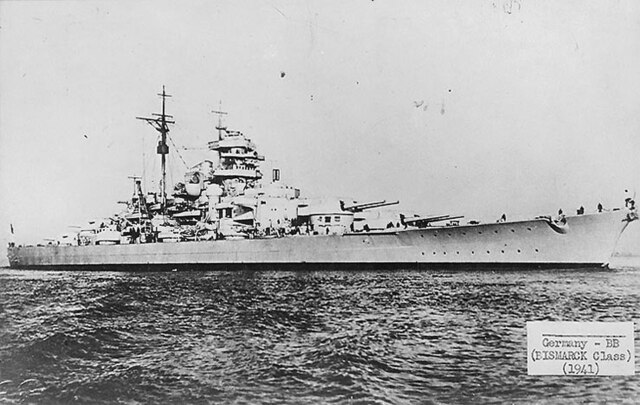At 8:47 a.m. on May 27, 1941, the British battleship Rodney opened fire on the German battleship Bismarck. Three minutes later, the Bismarck returned fire, but due to its position could not bring all of its guns to bear. This was the final battle of a nine day affair, one that not only decided which global superpower controlled the Atlantic, but sank Britain’s most famous ship and changed the face of warfare at sea forever.
The Bismarck was a German battleship, launched on February 14, 1939. It was 250 meters long, with a 30 meter width. It was incredibly advanced for its time, sporting torpedo resistant armor plating across its entire length, with additional heavy armor covering the conning tower. It had four gun turrets (two fore and two aft,) each one containing two 15-inch guns. Additionally, the Bismarck was designed to be fast, and a steady gun platform in all weather. The Bismarck’s top speed was 30 knots (about 35 miles per hour), and it could operate its full complement of weaponry in any weather at 28 knots. At the time, most ships’ top speed was 20-28 knots, and had to slow even further to be able to properly use their weaponry. The Bismarck was able to exert more force, and exert it faster, than any other vessel on the waves. On May 19, 1941, that’s exactly what it set out to do.
Under German Admiral Günther Lütjens, Bismarck began Operation Rheinübung. Sneaking out of the Baltic in the dead of night, Lütjens’ objective was to destroy, delay, or capture as much Atlantic shipping as possible. Britain was fighting alone in Europe after losing France to the Germans earlier in the year. Bismarck would cut off Britain’s last supply line, making sure they were fighting an unwinnable battle. Bismarck got underway at 2:00 a.m. on May 19, joining the Prinz Eugen, who was to accompany Bismarck during the operation. An additional eight smaller ships joined the two battleships to escort them out of the Baltic. At 1:00 p.m. the next day, the Swedish cruiser Gotland spotted the convoy, and reported its heading and location to the British Admiralty.
On the morning of the 21 of May, British Admiral John Tovey received a call from the Admiralty. He was instructed to pursue and destroy both Bismarck and Prinz Eugen. At his station in Scapa Flow, a naval base in the Orkney Islands in the northernmost part of Scotland, he was the closest to the Baltic. He ordered Vice-Admiral Lancelot Holland of H.M.S. Hood to sail with his squadron for the south of Iceland, a prime position to attack the Bismarck. No matter which coast Lütjens decided to sail around, Holland would be waiting.
Heavy Cruiser H.M.S. Suffolk and her sister ship H.M.S. Norfolk were patrolling the Denmark Strait on the evening of the 23 of May. Both were outfitted with a new type of tracking technology: radar. Though the Germans also possessed radar, their design was not nearly as powerful and accurate as the British model, which had been workshopped and upgraded over the years. Suddenly, Suffolk gained visual contact with two battleships—the Bismarck and Prinz Eugen—only seven miles away. She managed to slip into a bank of fog, but Norfolk was unsuccessfully fired upon by the Bismarck before she too was able to slip away. Norfolk radioed the Bismarck’s position to the rest of the fleet, while both cruisers began to shadow Bismarck. Keeping track of Bismarck’s position until Holland’s squadron could arrive was the most important thing.
Holland received the Norfolk’s transmission, and departed the coast of Iceland to meet them. However, as his squadron began to get underway, the weather worsened, and only H.M.S Hood and the H.M.S. Prince of Wales were able to continue. The Hood was the pride of the Royal Navy. Between the first and second world wars, Hood had toured the world, demonstrating British naval superiority around the globe. By many accounts she was a beautiful ship, the perfect touring vessel. However, because of her popularity during the interwar period, she was never refitted with modern armaments. She still had one major flaw. The Hood’s deck armor was very thin, as the effects of long-range fire had not been fully understood during her construction. This meant that Hood was especially vulnerable to plunging fire, shells fired at long range that fell almost straight down onto the deck. The two battleships engaged Bismarck and Prinz Eugen on the 24 of May at 5:52 a.m.
Opening fire, Holland ordered to fire on the first ship in the enemy line. Only too late did he realize that the ship was actually Prinz Eugen, and not Bismarck as he had thought. He’d wasted the element of surprise, and precious minutes bringing his guns to bear. Captain John Leach on the Prince of Wales spotted Holland’s error before it was too late, and fired on the Bismarck instead. Both British ships were only able to bring their fore guns to bear, attempting to close range before Hood could be subjected to any plunging fire. Prince of Wales scored the first hit, putting a shell straight through Bismarck’s bow. Two shells, in retaliation, struck Hood. Holland decided his range was close enough, and began to turn, bringing all eight of Hood’s 15-inch guns to bear. But it was too late. Just after 6:00 a.m., the Bismarck delivered a fatal plunging shell directly into Hood’s aft magazine. The battleship exploded, splitting in two and sinking in minutes. Out of a crew of 1,418, only three would survive. The world’s most famous battleship had been sunk by the Bismark.
With Hood out of the picture, Bismarck and Prinz Eugen then focused solely on the Prince of Wales. In the following five minutes, seven shells would strike the ship. One shell passed straight through the bridge, tearing the command center of Prince of Wales to shreds, killing almost everyone inside and wounding Leach. Leach knew he couldn’t take both battleships alone, and ordered a hasty retreat under the cover of a smokescreen. Along with the two heavy cruisers, they would continue to shadow the Bismarck and wait for support. Norfolk sent a message concerning Hood’s fate to the Admiralty.
Hood was an old ship, and could be replaced. It didn’t have much strategic value. Where Hood shined was its political power, the strong navy it represented while touring the world. Hood’s sinking was devastating news to the general public. But the British parliament was only invigorated by the loss. They needed a quick victory over Bismarck to raise morale, and ensure the continued support of the United States. Winston Churchill, Britain’s Prime Minister, sent the Admiralty a message to relay to all allied ships in the Atlantic. It read: “Sink the Bismarck.”
Back in Scapa Flow, Admiral Tovey moved his flagship, battleship H.M.S. King George V into the Atlantic. Battleship H.M.S Rodney, on its way to refit in America, turned around and began to head back towards Britain. Stationed at Gibraltar, Vice-Admiral James Somerville’s Force H squadron began to move out. The squadron consisted of the aircraft carrier H.M.S. Ark Royal, the light cruiser H.M.S. Sheffield, and the battlecruiser H.M.S. Renown. The Royal Navy was sinking Bismark at all costs. Norfolk, Suffolk, and Prince of Wales continued to shadow the Bismarck and Prinz Eugen. The shell that Prince of Wales put through Bismarck had been a lucky one, and ruptured the Bismarck’s fore fuel lines. The ship was leaking oil, creating a long trail of sparkling goo in the ocean behind it. This would make it easier to spot, especially from the air. At 6:40 p.m. on the 24, the Bismarck turned suddenly and fired on Norfolk. All three pursuers pulled back out of firing and radar range, planning to pick up Bismarck’s signal later. When they did, however, there was only one radar signature. Prinz Eugen had vanished. The attack had only been a distraction to allow Prinz Eugen to escape and begin sinking Atlantic commerce. At 3:00 a.m. the next day, Suffolk received a transmission from the Admiralty that the Bismarck was leading them into a very concentrated area of German U-boats. To avoid these submarines, all three ships once again pulled back from the Bismarck. Bismarck took advantage of this short retreat by sailing at full speed. Suffolk waited for a radar echo, but there was none. Bismarck had escaped.
Luckily, Bismark’s hiatus was short-lived. In Bletchley Park, Britain’s code breaking headquarters, the naval team was working to find Bismarck’s location. Their first clue was that messages to Bismarck were no longer being sent from Germany, but instead being sent from a Paris station in Vichy France. The real tip-off was a message received fourteen hours after the Bismarck had vanished. It was an encoded communication from a German general asking if his son survived the battle with Hood. Bismarck’s reply was that there were no casualties, and that they were headed to Brest, France. British forces were immediately informed of Bismarck’s course, and scouting flights were redirected from Norway (where it was thought that the Bismarck might go for repairs) to scan the ocean around France. Somerville’s Force H moved to intercept.
At 10:36 a.m. on May 26, 31 hours after it had last been sighted, a PBY Catalina flying boat spotted Bismarck 700 miles from France. It was not close enough to be under the protection of the German air force yet, but within a day it would be. Somerville ordered Ark Royal to send 15 Swordfish aircraft on a torpedo sortie. A new, magnetic activation torpedo was fitted to the bottom of each Swordfish. These weapons detonate by detecting the magnetic field produced by a ship’s metal hull. They should do more damage, and be more accurate than the usual contact detonators. The Swordfish launched into the air in terrible weather, near the limit of their operational capabilities. They were told that Bismarck was the only ship in the area.
Earlier, Sheffield was deployed by Somerville to begin shadowing Bismarck. At 4:10 p.m., seemingly out of nowhere, 15 Swordfish aircraft begin an attack run on the friendly light cruiser. Despite Sheffield flying British colors, 11 Swordfish still dropped their torpedoes. Luckily, the new magnetic torpedoes were faulty. Six of them detonated on contact with the water, while five headed towards Sheffield, which managed to dodge all of them. Once again, precious time had been wasted. The Swordfish made it back to Ark Royal, re-equipped with reliable contact detonator torpedoes, and deployed again at 7:15 p.m.
This was the first time that an important strike against a moving modern battleship was made entirely by aircraft launched at sea. This strike began an era of air power at sea, one that would be a significant factor in the Pacific Theater. The use of aircraft carriers as a force projection tool would be demonstrated with especially deadly effectiveness at Pearl Harbor and the Battle of Midway. The Bismarck was to be the first victim of this new tactic.
In the dwindling light, the Swordfish spotted Bismarck in the rough waves. They began their attack run. Bismarck employed all of its anti-aircraft batteries to shoot them down, as well as firing its main guns to create massive pillars of water in the approach in an effort to swamp the incoming aircraft. This effort was unsuccessful, however, as not a single plane was shot down. Instead, when the Swordfish dropped their payloads, two torpedoes found their mark. One hit the strong armor on the Bismarck’s side, but the other hit near the stern of the ship while it was making an evasive turn. Through a combination of luck and skill, Bismarck’s rudder was now locked 15 degrees to port. Lütjens sent a crew to assess the damage, but the rudder was ruled irreparable; the Bismarck could now only sail in circles. At midnight on the 27, Lütjens sent a final transmission to Germany: “Ship unmaneuverable. We shall fight to the last shell. Long live the Führer.”
Admiral Tovey arrived in King George V during the night, along with battleship H.M.S. Rodney. Rodney was an old ship, but had 16-inch guns at its disposal, some of the largest in the royal navy. Tovey’s plan was to attack in the morning from four different angles, forcing Bismarck to split its fire between four different ships. King George V, Rodney, Norfolk, and heavy cruiser H.M.S. Dorsetshire moved in, the battleships closing range quickly from the west. At 8:47 a.m., Rodney opened fire. Bismarck reciprocated the gesture at 8:50 a.m. Salvos went back and forth, Bismarck slowly finding its range on Rodney. Only 15 minutes after its first shot, Rodney scored a direct hit on Bismarck, severely damaging his bridge and destroying both of his fore turrets. Bismarck weakened as shells smashed into him from all directions. At 9:31 a.m., all four of Bismarck’s turrets were destroyed by combined fire from the attacking British ships. In naval custom, a ship has to strike their colors (lower their flag) in order to surrender. According to eyewitnesses, the Bismarck’s deck was a burning wreck, and there were no longer any colors to strike. “It was a rather bloody business. One had to go on to sink the ship,” said William Crawford, recollecting the event. He was aboard Rodney during the battle. All four ships pummeled Bismarck, but he refused to sink. At 10:20 a.m., Dorsetshire was ordered to fire torpedoes on the listing Bismarck. Before it could, the remaining Germans on board blew demolition charges to sink Bismarck on their terms. At 10:40 a.m. on the 27 of May, 1941, Bismarck slipped below the waves, taking 2,107 of his crew with him, including Admiral Lütjens.
114 crew members of the Bismarck survived, including a ship’s cat, named Oscar by the crew of the destroyer H.M.S Cossack. Cossack sank only six months later on October 27 due to damage caused by a torpedo fired from a German U-boat. Oscar once again survived, now aboard Ark Royal, where the crew gave him the moniker “Unsinkable Sam.” The Ark Royal was also sunk by a German torpedo only 18 days later, and yet again Oscar survived. However, this would be the end of his seafaring career, and he was moved to a sailor’s home in Belfast where he lived until his death in 1955. The sinking of the Bismarck put an end to German sea power, at least above the water. The Royal Navy once again possessed dominion of the Atlantic. Control of the sea around Britain was vital to the war effort, the first building block for future actions such as Operation Overlord in 1944. This battle began an era of aerial combat at sea, which has not changed to this day. Aircraft are used as a force multiplier, able to attack targets over the horizon. As aircraft have become more advanced, carriers have only gained more strategic value. The sinking of the Bismarck was a vital turning point in the state of the Atlantic Theater during World War Two.
The Bismarck during Sea Trials after his completion in 1940. These trials established that the top speed of the ship was 30 knots. Image Credit: Wikimedia Commons.






Be First to Comment